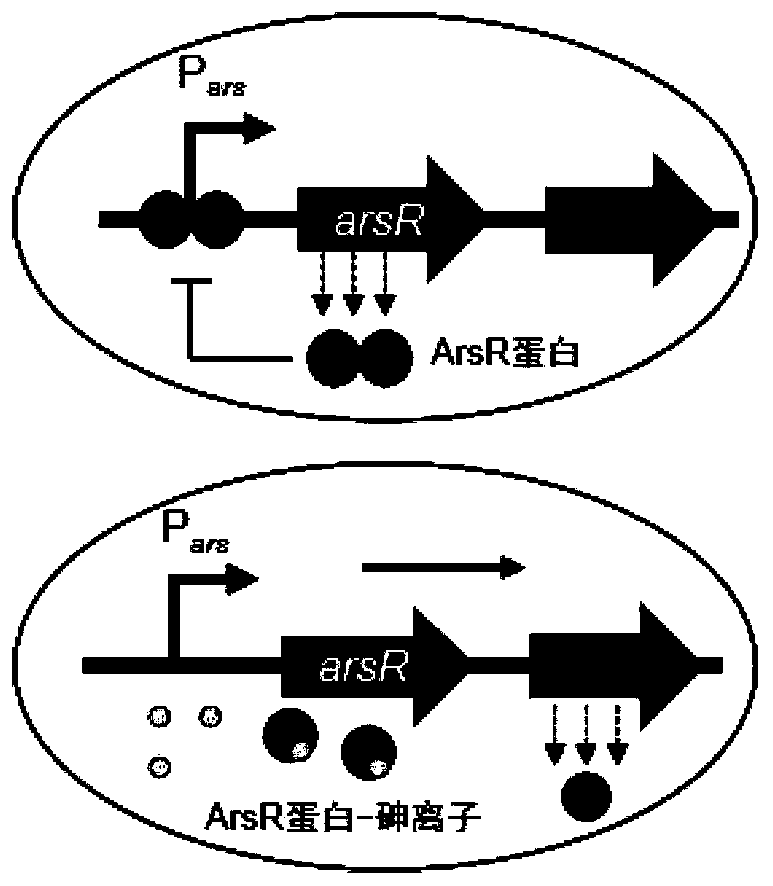Construction of sensitive arsenic ion whole cell biosensor and arsenic ion concentration detection method
A technology for biosensors and construction methods, applied in the field of construction of arsenic ion whole-cell biosensors, can solve the problems of low sensitivity and poor specificity, and achieve the effects of wide adaptability, high sensitivity and specificity
- Summary
- Abstract
- Description
- Claims
- Application Information
AI Technical Summary
Problems solved by technology
Method used
Image
Examples
Embodiment 1
[0036] Example 1 Construction of a sensitive whole-cell biosensor capable of detecting the content of arsenic ions As(Ⅲ)
[0037] 1. Construction of detection plasmid pCDF-As-luxR (attached figure 1 shown)
[0038] Arsenic-specific promoter P amplified by PCR ars (SEQ ID No.1) and the nucleotide shown in the specific binding protein gene arsR sequence (SEQ ID No.2), i.e. fragment P ars -arsR. in fragment P ars BamHI and EcoRI restriction sites were added to both ends of -arsR respectively. Use FastDigest endonuclease for digestion, the reaction system is: 5 μL 10*FD buffer, 2.5 μL BamHI, 2.5 μL EcoRI, 30 μL P ars -arsR fragment and 10 μL of ultrapure water. The reaction conditions are: 37°C, 2h. Using a PCR purification kit, add 250 μL of Bingding Buffer solution to 50 μL of the digested product, mix well, add to the adsorption column, let stand for one minute, centrifuge at 10,000xg for 1 minute, and discard the effluent. Add 650μL Wash Buffer, centrifuge at 10,000g ...
Embodiment 2
[0050] Example 2 Detection of arsenic ion As(Ⅲ) by target whole-cell biosensor
[0051] 1. Fermentation of target whole-cell biosensor chassis cells and fluorescence detection induced by arsenic standard solution
[0052] The target whole-cell biosensor chassis cells were inoculated in LB culture-based test tubes according to the inoculum amount of 1%, and cultured overnight at 37° C. and 220 rpm for 14 hours to obtain a seed culture solution. Take the seed culture solution according to 1% inoculum amount, transfer it to 5 mL non-resistant LB medium test tubes, add arsenic ions As(Ⅲ) to different test tubes respectively, so that the arsenic ions As(Ⅲ) in each test tube The final concentrations were 0, 0.01, 0.05, 0.1, 0.5, 1, 5, 10, 50, 100, and 200 μM, and three parallel samples were set for each concentration of arsenic ion As(Ⅲ), and incubated at 37°C and 220rpm for 8h .
[0053] Samples were taken for absorbance and fluorescence signal detection. The absorbance is measu...
Embodiment 3
[0058] Example 3 Detection of arsenic ion As(Ⅲ) by target whole-cell biosensor
[0059] The target whole-cell biosensor chassis cells were inoculated in a test tube containing LB medium according to a 2% inoculation amount, and cultured overnight at 37° C. at 220 rpm for 12 hours to obtain a seed culture solution. Take the seed culture solution according to 2% inoculum amount, transfer it to LB medium test tubes containing 5 mL of non-resistance, and add arsenic ions As(Ⅲ) to different test tubes respectively, so that the arsenic ions As(Ⅲ) in each test tube The final concentrations were 0, 0.01, 0.05, 0.1, 0.5, 1, 5, 10, 50, 100, and 200 μM, and three parallel samples were set for each concentration of arsenic ion As(Ⅲ), and incubated at 37°C and 220rpm for 8h .
[0060] The remaining experimental steps and data processing are the same as in Example 2, and the experimental results are also the same as in Example 2.
PUM
 Login to View More
Login to View More Abstract
Description
Claims
Application Information
 Login to View More
Login to View More - R&D
- Intellectual Property
- Life Sciences
- Materials
- Tech Scout
- Unparalleled Data Quality
- Higher Quality Content
- 60% Fewer Hallucinations
Browse by: Latest US Patents, China's latest patents, Technical Efficacy Thesaurus, Application Domain, Technology Topic, Popular Technical Reports.
© 2025 PatSnap. All rights reserved.Legal|Privacy policy|Modern Slavery Act Transparency Statement|Sitemap|About US| Contact US: help@patsnap.com



